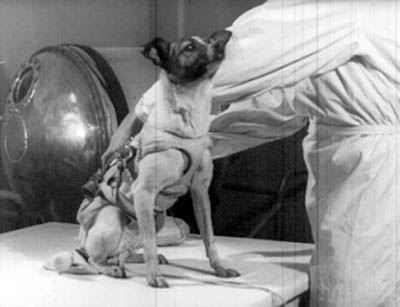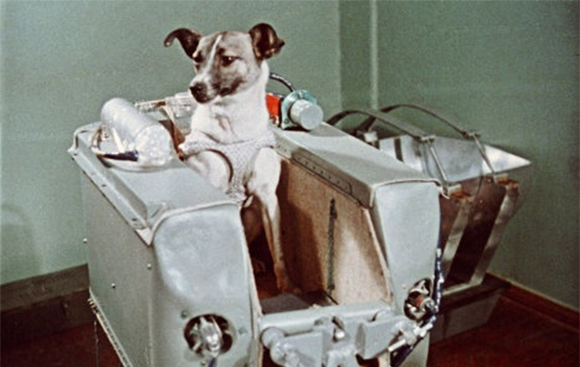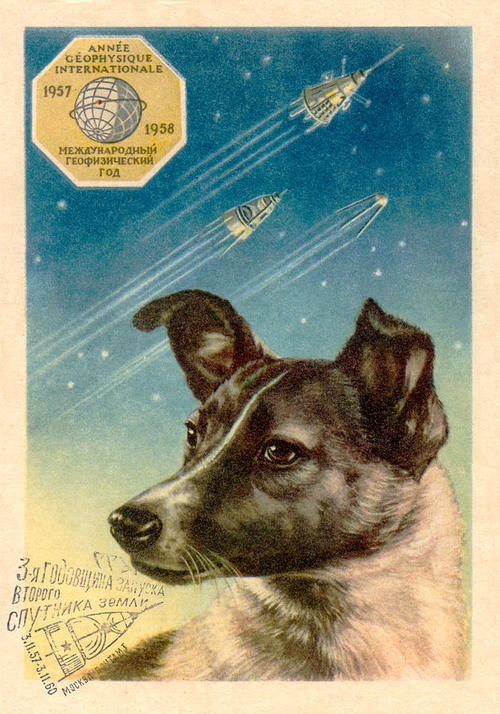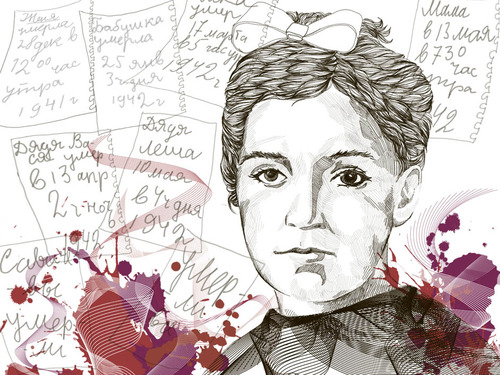The Nedelin Catastrophe
In late October of 1960, nearly 200 families around the Soviet Union got letters notifying them that a loved one had died in a plane crash. It took thirty years for the public to be informed of what actually happened. It’s known as the Nedelin Catastrophe, and it’s one of the most chilling accidents of the nuclear age.
“On August 3, 1957, the Soviet Russian R-7 Semyorka missile, called “Little Seven” by the men who worked around it, flew a simulated nuclear strike trajectory, then became a space launcher just two months later, on October 4, by launching Sputnik. A great international triumph, then, but in missile terms, not necessarily the military advantage that Russia wanted.
The Semyorka used kerosene and LOX. Who in their right mind wants a nuclear missile that takes three or four hours to prime with LOX before you can launch it? Not the Soviet Red Army, for sure. So they commissioned an even more secret missile, the R-16, which, in theory, could be fueled and primed several days, or even weeks, before it was needed, with no loss of oxidizer, because its engineers had abandoned super-cold LOX and kerosene in favor of nitric acid and hydrazine: hypergolic fuels… a fuel and oxidizer combination that can be stored indefinitely at normal pressures and temperatures.
Hypergolic chemicals are efficient too. They ignite spontaneously on contact with each other and deliver a pretty good bang for your buck. Of course there’s a downside. Hypergolics are among the nastiest and most toxic substances in the rocket business. Did we mention that they can be stored? Well, sort of. They are so corrosive they will play havoc with any part of your rocket (or your people) that they come into contact with that they shouldn’t….
In October 1960, the R-16 was hoisted upright for launch at Baikonur, Russia’s ultrasecret equivalent of Cape Kennedy, based deep in the deserts of Kazakhstan. And so began the single greatest rocket disaster in history.
The R-16’s “storable” fuels wouldn’t store. They were viciously corrosive and leaky as hell, oozing from dozens of pipe joints and tank seams. On October 23, the surrounding launch gantries were crowded with young technicians trying to fix a dozen different problems. As zero hour approached, the rocket began to drip nitric acid from its base. At this point, launch director Mitrofan Nedelin should have ordered the entire gantry to be evacuated, but he didn’t seem to care about the risks. He sent yet more ground staff into the pad area straightaway, to see if they could tighten up some valves and stop the leaks and get the rocket up in the air.
Suddenly, the rocket exploded, instantly killing everyone on the gantry. With nothing to support it, the upper stage crashed to the ground, spilling fuel and flame. The new tarmac aprons and roadways around the gantry melted in the heat, then caught fire. Ground staff fleeing for their lives were trapped in the viscous tar as it burned all around them. The conflagration spread for thousands of yards, a wave of fire engulfing everything and everyone in its path. More than 190 people were killed, including Nedelin, perched on his chair near the gantry as a surge of blazing chemicals swept toward him.” (From Piers Bizony’s How To Build Your Own Spaceship)
- The deadliest launch pad accident in history.
Victims of government pressure.
Its the same kind of pressure that pushed NASA to go for a Challenger launch in near zero degree weather even though the engineers said the o-rings in the boosters would shrink, causing a burn-through and explosion.
Laika (c. 1954 – November 3, 1957) was a Soviet space dog who became one of the first animals in space, and the first animal to orbit the Earth.
Laika was a stray dog, originally named Kudryavka (Russian: Кудрявка Little Curly); she underwent training with two other dogs, and was eventually chosen as the occupant of the Soviet spacecraft Sputnik 2 that was launched into outer space on November 3, 1957, (becoming the first dog in space, to orbit the Earth, and was also the first animal to die in space.) The Soviets designed the spacecraft knowing she would not survive. One Soviet scientist took her home to play with his children because he said “I wanted to do something nice for her. She had so little time left to live.” Laika likely died within hours after launch from overheating, possibly caused by a failure of the central R-7 sustainer to separate from the payload. The true cause and time of her death was not made public until 2002; instead, it was widely reported that she died when her oxygen ran out on day six, or as Soviet government initially claimed, she was euthanized prior to oxygen depletion.
As a kid who was very into rockets and airplanes I remember being told about her (mind you, I wasn’t born until the cold war was ending), but in my childish innocence I assumed she came back okay.
Here’s a statement made by Oleg Gazenko, one of the Sputnik scientists:
“Work with animals is a source of suffering to all of us. We treat them like babies who cannot speak. The more time passes, the more I’m sorry about it. We shouldn’t have done it… We did not learn enough from this mission to justify the death of the dog.”
You know what makes me (sorta) happy? They built her a window. Despite the challenges and costs of building a secure window in a pressurized capsule, they did it so the dying dog could look out.
Source here:
Gazenko speaks of the bond that grew between the dog and him as they worked toward her mission, leading us in unembroidered prose through a brief tale of preparation, hours of readiness on the launch pad, and the launch itself. But the heart of the article for me, and the part to which nothing I’ve found since makes reference, is this: Gazenko tells us that as engineers rushed against deadlines to complete the capsule that would carry the dog into space, outfitting it with equipment to record the details of her death, he took on a battle in Laika’s behalf. Against heavy objections from the decision-makers, he insisted upon the installation of a window. A window in a space capsule, where such a luxury would cause complications and expenses that I can barely imagine. A window for the dog whose monitored demise had been this man’s objective in all the interactions that had bonded her to him with the eager devotion of every well-trained working canine.
Yet Gazenko persisted and prevailed.
Roof In Peace.
The charred remains of cosmonaut Vladimir Komarov on view in an open casket during his state funeral after the crash of the Soyuz 1, 1967.
Welcome to the Soviet Union.
Komarov’s story has always hit me particularly hard. He went up knowing he would likely die to spare his best friend from the same fate. (It’s tragic, they knew his space vehicle had issues, and he was sent anyway.)
“With less than a month to go before the launch, Komarov realized postponement was not an option. He met with Russayev, the now-demoted KGB agent, and said, “I’m not going to make it back from this flight.”
Russayev asked, Why not refuse? According to the authors, Komarov answered: “If I don’t make this flight, they’ll send the backup pilot instead.” That was Yuri Gagarin. Vladimir Komarov couldn’t do that to his friend. “That’s Yura,” the book quotes him saying, “and he’ll die instead of me. We’ve got to take care of him.” Komarov then burst into tears.” (Source)
According to the book by Colin Burgess, Soyuz 1 hit the ground at around 120 miles an hour. Small braking rocket engines …designed to fire moments before touchdown, exploded on impact. The …wreckage erupted into flames, …so fierce that the aluminium outer sheet melted and pooled on the ground. …recovery crews could do little but extract what they could find of Komarov’s charred remains. They did not know the parachutes would get tangled and he could only have become aware of the fatal problem in the very last couple of moments.
No one should have to suffer like that. I hope he passed as easily as possible, it’s hard to imagine such suffering.
(Those guys had massive balls participating in the early space programs when we were figuring things out as we went along.)
Soviet Red Army officers standing beside a pile of human ashes in the Majdanek concentration camp, 1944
In Soviet Russia, music criticizes you!
Dmitri Shostakovich’s Symphony no. 7 “Leningrad”
- It was completed December 27, 1941 and was written as a heroic symbol of resistance to Nazi totalitarianism invading Russia. It’s been criticized for its often simplistic and bombastic sounds but others argue that was Shostakovich’s way of criticizing Stalin and the totalitarianism in the Soviet Union – simple, childlike, often obnoxious, over the top, and monstrous underneath. (It was also performed in the city during the siege of Leningrad. They shelled the German lines and then broadcast the symphony live across the wire. )
Life and times
Dmitri Dmitriyevich Shostakovich (Дмитрий Дмитриевич Шостакович, 1906-1975) is probably more popularly associated with Soviet Russia than any other composer. He was a child prodigy, but his adult career flourished during Joseph Stalin’s reign of terror, and this influenced his art very directly. In 1936, Comrade Stalin attended a performance of Shostakovich’s opera Lady Macbeth of the Mtsensk District; although the opera had previously been praised by the Soviet press for its ideological correctness, Stalin quite visibly did not enjoy it. Two days later, an editorial in Pravdacalled the opera “Muddle Instead of Music” and suggested that things “may end very badly” for Shostakovich. In this first prototype of the Communist regime’s new mechanism of cultural control, critics who had previously praised Shostakovich’s work publicly revised their opinions; he lost most of his commissions and performance engagements, and several of his friends and family were soon imprisoned or executed.
Shostakovich’s response was the Fifth Symphony, which he advertised as an apology for Lady Macbeth: “an artist’s creative response to just criticism”. Thus began a series of apparently patriotic compositions to gradually restore his official favor with Stalin and the musical authorities. Most of this work is ignored today, with some exceptions like the wartime Seventh Symphony (“Leningrad”). Meanwhile, Shostakovich wrote his most personal feelings into “desk drawer” compositions, mainly piano solos and especially chamber music, not meant for public performance.
Of course the biggest event in restoring Shostakovich’s public reputation was Stalin’s death in 1953, the same day as Sergei Prokofiev’s. Shostakovich ostensibly commemorated Stalin with his Tenth Symphony, and many of his earlier works were finally premiered. In fact, he regained so much favor with the Khrushchev regime (fortunately, Khrushchev had no ear for music that he joined the Communist Party to become General Secretary of the Composer’s Union; by this point, younger composers were happily studying forbidden musical concepts like serialism, and Shostakovich suddenly seemed like an icon of conformity. It’s not clear what was going through Shostakovich’s head, even from his own conflicting accounts, but soon he wrote the Eighth String Quartet – some previous works had been dedicated to friends and family who perished under Stalin, but this one was privately dedicated to himself, a musical suicide note.
Though the quartet trailed off in a signature morendo, Shostakovich survived, turning inward to psychological pessimism and dread for his late period. Despite his conservatism, he influenced a school of younger successors, including Alfred Schnittke.
Music
Even when Shostakovich seemed to be at his most patriotic, did he really mean it? Or did the apparently simple-minded themes sit on a layer of irony, concealing deep commentary on Soviet repression? And were these messages meant to be recognized by audiences while eluding official critics? These allegations are made in a supposed memoir, but historians question its authenticity.
At any rate, Shostakovich’s music is structurally conservative and old-fashioned for the time, official Soviet policy on “formalism” notwithstanding. Nearly all his work is quite clearly and accessibly tonal, with some extensions or tidbits of chromaticism. With fifteen string quartets and fifteen symphonies, often with roughly traditional movement orders, he was certainly one of the most prolific composers of these backward-looking genres in the twentieth century. And backward he did look: he was fond of quoting melodies from other composers or himself, and channeled Bach in his own preludes and fugues. Even his most personal chamber music generally follows the same formal and tonal idioms as his symphonies meant for public consumption.
From Mahler, he took not just orchestration but the concept of the symphony as psychodrama (Boulez: “the second, or even third pressing of Mahler”). His late string quartets show an affinity with Beethoven’s, in much the same respect. He was influenced by many Russian composers, including contemporaries like Prokofiev and Stravinsky as well as the old greats like Tchaikovsky and especially Mussorgsky. Though it’s not immediately apparent to the ear, he counted the Second Viennese School among his strongest inspirations.
Some examples
- Symphony No. 5, especially the finale, and the 2nd movement (in that order)
- Symphony No. 10, 2nd movement (fantastic 4-minute portrait of Stalin, with the three-note motif reminding one of “KGB”)
- String Quartet No. 8, 2nd movement (tumultuous “whole note = 120” piece with amazingly big sound with lots of DSCH and dissonance and crunchy double stops sprinkled all around, dedicated to ostensibly the victims of fascism, but really himself and his fellow countrymen)
- Symphony no. 7 “Leningrad” (quoted as the longest orchestral crescendo, topping even Bolero, used to evoke the oncoming Nazi army into Leningrad)
But, people seem to never talk about Symphony No. 4, which is my personal favorite.
Scored for a Mahlerian orchestra and stuffed with the most jarring dissonances, it begins with a shocker and closes with a triumph that subsides into a slow death. Indeed, I believe that the ending of Symphony No. 4 is THE MOST CHILLING ending of all time. Nothing tops this… a heartbeat in the timpani + sustained floating c minor chord in the violins + undulating celeste figure that all fades away.










